#araihari
Explore tagged Tumblr posts
Note
Hello! I keep reading fiction with kimono hemmed to fit, and I keep thinking that can't be right. I can see it if their genes mean widening shoulders, but aren't kimono folded and tucked under the obi? Thank you for looking over this detail. (I'll stay anonymous because it's an honest mistake, and I don't want specific writers to feel cornered about it)
Hi! Np for this anon ask, I'll just stress here I most often reply via Tumblr messenger so don't hesitate to ask for private answer if you need it :)
On to your question: you are right, hemming (in the Western sense of the word) a kimono is not usually done in traditional Japanese tailoring.
One of the main reasons is that fabric bolts (tanmono) are a somehow standard unit, with patterning done with kimono tailoring in mind (so motifs match between panels etc).

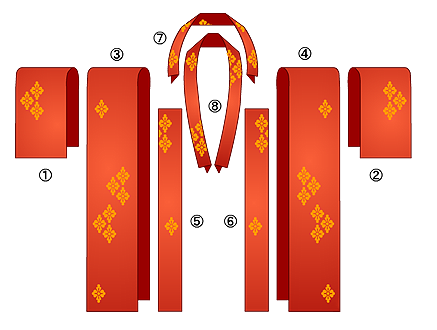
Hemming a kimono means important parts of your kimono design will disappear! It is especially true for woman's kimono who often often display patterns on their lower skirt + sleeves.
When you wear a kimono with woman styling, the kimono is supposed to be more or less your total height to fit you size. The extra material is then tucked at the waist to form what is called the ohashori fold hold up by ties (himo). That fold gives you leeway as to which kimono you can wear as it is much more forgiving than Western clothes sizing. Being tall simply mean your ohashori will be small or non existent.
Men styling is a bit different as men don't do ohashori, which mean the kimono is tailored to their exact size (= give or take your height minus 30cm).
Kimono were usually passed to new wearers as time went, which means they are supposed to be worn by several body types. So, what about when a kimono is truly too big/small for the wearer?
Fabric was once (and still is) an expensive material so cutting it was a big no! Cutting also meant loosing the original tanmono panneling which was a terrible thing to do for any future alterations.
We so have two scenarios:
1) the wearer is a child: tucks are made at the shoulders (kata age) to reduce width, waist (koshi age) to reduce lenght, and sleeves (sode age). You can see in this past note a great example showing how a kid grew into a kimono:
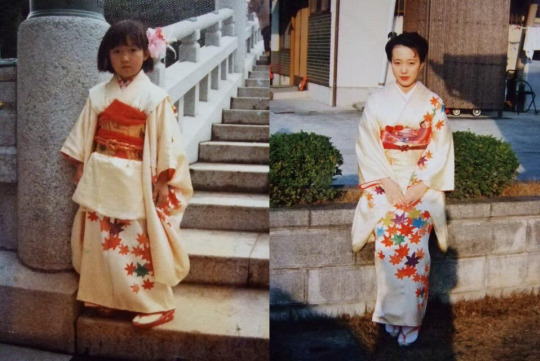
2) The wearer is an adult: the kimono would have been totally unsewn, and then sewn back together, hiding the extra material into seams/letting the fabric needed for bigger wearer.
Taking a kimono apart is not especially unheard of, and it is actually the traditional way to clean it (tokiarai = unstitching a kimono and washing / araihari = stretching pieces of a kimono on boards to dry after they have been washed and starched). You can see it done here:
youtube
Becky from Silk and bones has many kimono specimen photographed if you want to actually see how they are made - and just how much fabric can be hidden away into seams + how disastrous and infuriating it is to have a kimono with butchered cut fabric :(
TL:DR : People don't "hem" their kimono to wear them, women for ex. tuck the extra fabric away and go in their merry way. If sewing is needed, "hemming" is not exactly what would be done in kimono tailoring. A better way to describe it would probably be "adjusted" or "altered" to size :)
#ask#japan#fashion#fashion history#kitsuke#kimono tailoring#hemming#kimono size#sewing#shoulder tucks#waist tuck#sleeve tuck#sode age#kata age#koshi age#tanmono#fabric roll#ohashori#men kimono#washing kimono#tokiarai#araihari#kimono alteration#着物#帯
460 notes
·
View notes
Text
Who Is Higuchi Ichiyou? (Spoilers if you haven’t fully watched/read Bungou Stray Dogs)
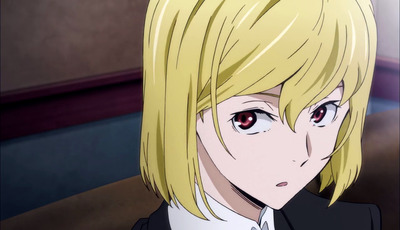
Higuchi Ichiyou, a port mafia member and the one who commands the Black Lizards. She isn’t respected by the mafia, she isn’t useful to the mafia ability wise but why is she here?
Let us begin from the beginning.
Who is the real life Higuchi Ichiyou?
She was born on May 2, 1872 in a nagaya (row house) on the premises of the Tokyo prefectural office (present Chiyoda Ward, Tokyo Prefecture) in Uchisaiwaicho, Ichi shoku, Daini daiku, Tokyo-fu (Tokyo Prefecture). Her real name was Natsu HIGUCHI. Her father was Tamenosuke (Noriyoshi) HIGUCHI and her mother was Ayame, the fifth daughter of the Furuya family; Ichiyo was their second daughter. She had an older sister (Fuji) and two older brothers (Sentaro and Toranosuke), and was followed by a younger sister (Kuni). Making Higuchi Ichiyou the fourth child.
Her father, Noriyoshi, was a peasant in Nakahagiwara Village, Yamanashi County, Kai Province (present Koshu City, formerly Enzan City). Her grandfather seems to have been familiar with creative writings such as haikai (seventeen-syllable verse) and keisho (the most important documents in Confucianism); it is said that Noriyoshi preferred academics to farming and, as his marriage with Ayame was not permitted, they practically eloped to Edo. Noriyoshi began as a servant in the Bansho shirabesho (a government-run Western studies education and research institute) and, by good fortune, became a jikisan (immediate retainer) of the bakufu (Japanese feudal government headed by a shogun) by buying a kabu (a right to become doshin) of doshin (a low-ranked official) in 1867. After the Meiji Restoration, he became a low-level official and acquired the status of shizoku (a family or person of samurai ancestry), but was dismissed in 1876. After that, he made a living by working as a real estate broker and similar things.
As a young child, Ichiyo was raised in a family of moderate means, and she enjoyed reading from the time she was small; she read kusazoshi (illustrated story books) and it is said that she read through "Nanso Hakkenden" (a story of eight samurai and a princess of the Satomi family in the Nanso region) by Bakin KYOKUTEI when she was seven years old. In 1877, she entered Hongo Shogakko (Hongo Elementary School), but could not continue because she was too young, so she enrolled in Yoshikawa Gakko (Yoshikawa School), which had been established privately by Tomikichi YOSHIKAWA. In 1881, Toranosuke, her second older brother, set up a branch family and apprenticed himself to an earthenware painter. The family moved to Okachimachi, Shitaya Ward in the same year, so in November, she transferred to Seikai Gakko, a private school, in Ueno Motokuromoncho. She graduated from the fourth grade of the advanced course at the top of her class, but left the school without advancing to the upper grades. It is said that this was because her mother, Ayame, believed that studies were unnecessary for women.
On the other hand, it is said that her father, Noriyoshi, recognized his daughter's literary talent and let her learn waka from his acquaintance, Shigeo WADA. In 1886, she entered the waka school 'Haginoya,' run by Utako NAKAJIMA, through an introduction by Choan TODA, an acquaintance of her father from the days of the Tokugawa shogunate. In this school, besides waka, she studied classic literature and Japanese calligraphy of the Chikage school; dynastic style literature, such as The Tale of Genji, was the motif of Ichiyo's early works. During her time at Haginoya, Ichiyo met her close friends Natsuko ITO and Tatsuko TANABE and gave lectures as an assistant teacher. At that time, Haginoya was a waka school attended by the wives and daughters of the former regime's privileged classes - such as court nobles, former roju (senior councilor of the Tokugawa shogunate), and former domain lords - and of the Meiji government statesmen and military personnel. Although Ichiyo was shizoku, since her family had been farmers, she was treated as a commoner; she became introverted, and senior pupils from the upper social class called her 'monotsutsumi no kimi' (literally, close-natured person). When the first annual New Year's opening ceremony since Ichiyo had entered the school drew near, the topic of conversation among the well-bred young ladies turned to clothing and festive dress, well beyond the range in which the daughter of a low-class government official could compete. However, she quashed her feelings of inferiority and attended the ceremony wearing old clothes that her parents had borrowed.
Ichiyo's family moved frequently; Ichiyo moved twelve times in her life. In 1888, Sentaro, the first son and head of the family, died; Ichiyo inherited the family and became its head, with her father as guardian. In 1889, Noriyoshi's attempt to establish an association of draying contractors failed, and he died in July of the same year.
Ichiyo's engagement to her fiance, Saburo SHIBUYA, was cancelled. It is said this was due to the fact that, although the Higuchi family was left with a large amount of debt after Noriyoshi's death, Saburo HIGUCHI required a large amount of yuinokin (betrothal [gift] money). At the age of 17, Ichiyo was forced to support her family as its head and, in 1890, she lived in the house of the Nakajima family as a Haginoya apprentice. In September of the same year, she moved to Kikuzaka, Hongo (Bunkyo Ward, Tokyo Prefecture) and, along with her mother and younger sister, was obliged to live a hard life doing needlework and araihari (washing, stretching and drying various parts of kimono). It is said, however, that Ichiyo herself tended to disdain labor, and that the needlework and araihari were conducted by her mother and younger sister.
As Ichiyo's nearsightedness made her bad at detail work, she searched for other ways to earn income. When she learned that Kaho TANABE, a pupil in the grades ahead of her, had obtained a large manuscript fee for her novel "Yabu no Uguisu" (literally, Bush Warbler in a Thicket), Ichiyo made up her mind to write novels. At the age of 20, she wrote 'Kareobana Hitomoto' (Withered Grass). She used her pen name 'Ichiyo' for the first time in an essay written that same year. In order to make a living as a novelist, she also studied under Tosui NAKARAI, who reported on novels for the Asahi Shimbun, frequented a library, and published her first novel 'Yamizakura' (literally, Cherry Blossom in the Dark) in the first issue of the magazine 'Musashino,' presided over by Tosui. Afterwards, Tosui continued to take care of Ichiyo, who lived in dire poverty. Gradually, Ichiyo began to have amorous feelings for Tosui. However, a scandal about their relationship spread (although both were single, the customs of the time did not approve of such associations between a man and a woman without the intent to marry), and so she severed relations with Tosui. As if to emphasize the end of her relationship with Tosui, she published "Umoregi" (literally, Buried Wood), an idealistic novel in the style of Rohan KODA; it was completely different from her previous works, and it became the one that made her career.
Ichiyo became acquainted with Toson SHIMAZAKI and Tokuboku HIRATA, both of whom were well-versed in European literature; having come into contact with naturalistic literature, Ichiyo published multiple works including 'Yuki no Hi' (literally, Snowy Day) in 'Bungakukai.'
Her former fiance, Saburo SAKAMOTO (the Saburo SHIBUYA mentioned above) had become a prosecutor; around this time, he proposed to her, but she refused him. In order to relieve her straightened circumstances, she opened a variety shop which sold cleaning implements and penny candy in Shitaya Ryusenji-cho (present Ryusen 1-chome, Taito Ward), but closed the shop in May 1894 and moved to Maruyama Fukuyama-cho, Hongo Ward (present Nishikata 1-chome). Her experience on this occasion later became the subject of 'Takekurabe,' her representative work. She continued writing. In December, she published 'Otsugomori' (literally, New Year's Eve) in 'Bungakukai' and the next year, in 1895, 'Takekurabe' was published in seven installments, beginning in January.
Between the two works, she published 'Yuku Kumo' (literally, Going Cloud), 'Nigorie,' 'Jusanya' and others; the period from 'Otsugomori' to 'Uramurasaki' (literally, Purple on the Verso) is called her 'miraculous 14 months.'
In 1896, when 'Takekurabe' was published in its entirety in 'Bungei Kurabu,' it won great acclaim from Ogai MORI, Rohan KODA and others; Ogai MORI praised Ichiyo very highly in 'Mezamashigusa,' and many members of 'Bungakukai' began to visit her. In May, she published 'Warekara' (literally, From Myself), and 'Tsuzoku Shokanbun' (literally, Popular Epistle) in "Nichiyo Hyakka Zensho" (literally, The Daily Encyclopedia). Ichiyo had advanced tuberculosis and, when she was diagnosed in August, it was judged hopeless. On November 23, she died at the age of 24 years and 8 months. Ichiyo's life as a novelist lasted only a little over 14 months and in 1897, the year following her death, "Ichiyo Zenshu" (literally, The Complete Collection of Ichiyo's Works), and "Kotei Ichiyo Zenshu" (literally, The Revised Complete Collection of Ichiyo's Works) were published.
Her grave was in the annex temple of Tsukiji Hongan-ji Temple, the Higuchi family's ancestral temple, and was later moved to the Wadabori byosho (mausoleum) of Nishihongan-ji Temple in Izumi, Suginami Ward. Her homyo (posthumous Buddhist name) in Jodo Shinshu sect (the True Pure Land Sect of Buddhism) is Choshoin Shaku Myoyo. Literary materials including handwritten manuscripts and other related materials are kept by the Museum of Modern Japanese Literature and Yamanashi Kenritsu Bungakukan (literally, Yamanashi Prefectural Museum of Literature). Since November 2004, her portrait has been used on the Bank of Japan's five thousand yen note.
Now that we know her real life counterpart lets review her anime/manga self.
As a mafioso, Higuchi proves ruthless and fearsome, not shying away from killing her targets. When confronted by the enemy, she has a distant atmosphere to herself, often strictly no-nonsense and showing little sympathy for them. Quick to act, she seldom tolerates disrespect and detests those who underestimate Port Mafia.
However, Higuchi's personality, as her boss and she herself notes, is rather unfit in the Port Mafia. Beneath her tough exterior, she is easy to upset, hesitant, and quick to question herself. She even contemplated leaving several times, despite the inevitable hardships defection foretold. As a result, her subordinates seldom show her respect, many following her orders out of fear of Akutagawa's wrath. An impulsive spirit also leads her to tend toward drastic measures, consequently going against orders.
Her biggest weakness is her intense, bordering obsessive loyalty to Ryunosuke Akutagawa, whom she obeys almost unconditionally. She often insists on filling in for Akutagawa, worried about his poor health. Unfortunately, her loyalty is met with a frustrated Akutagawa's abusive and harsh treatment, often being called "unnecessary" to him. Nonetheless, Higuchi remains loyal to him. Her instinct to tell Akutagawa everything she knows ends up a key component to luring Akutagawa to the Guild's Moby Dick. However, Higuchi makes up her weaknesses for having a strong resolve, and she refuses to turn away when allies, especially Akutagawa, are in danger.
Thankfully, her determined and honest nature earns her Black Lizard's respect. She proves reliable and incredibly brave, even if her judgment is easily clouded under pressure. Even if questioning her position in the mafia, Higuchi shoulders its burdens and responsibilities to this day, understanding its vital role in Yokohama's safety. She also makes it a point to not be unnecessarily cruel to her opponents, acting strictly professional in Akutagawa and Port Mafia's names.
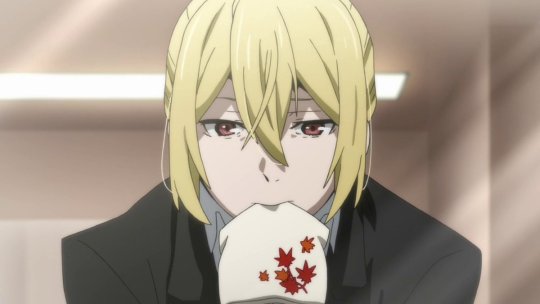
Her composure can often waver. Sometimes she is cool-headed and intimidating, other times easily unsettled and stressed out. Ultimately, she seems to excel more in covert operations than the frontlines, as a tendency to panic leaves her wide open in battle.
Higuchi however has some...strange relationship with the boss however. And this is mostly with what was already established above that the real life Mori Ougai had praised her work which made her very popular. So far in the anime there are three people who Mori Ougai seems close with;
Fukuzawa Yukichi, Yosano Akiko and Natsume Soseki.
Ogai MORI (February 17, 1862 - July 9, 1922) was a novelist, critic, translator, playwright, surgeon of the Imperial Army and Bureaucrat (Senior Official First Class). He was also Army Surgeon General (equivalent to Lieutenant General), Shoshii (Senior Fourth Rank), Order of Merit Second Class, Ko Third Grade, Doctor of Medical Science and had a doctorate in Literature. He is considered one of the great writers of the post-First World War Period ranked alongside Soseki NATSUME. His real name was Rintaro. He was born in Tsuwano Domain, Iwami Province (present Tsuwano-cho, Shimane Prefecture). He graduated from the University of Tokyo, Faculty of Medicine.
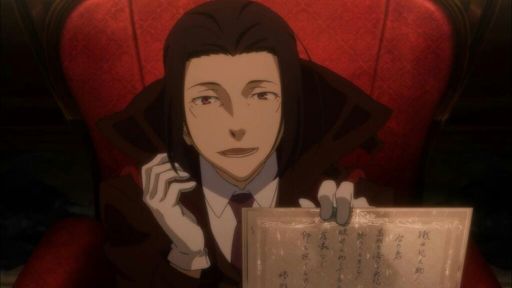
Shiyo Ho was born as the third daughter of Soshichi HO (father) and Tsune (mother) who ran a long-established Japanese confectionery shop 'Surugaya' in Kaino-cho, Sakai City (present-day Kaino-cho, Sakai Ward), Osaka Prefecture. One of her real brothers was Hidetaro HO who later became an electrical engineer. Shiyo entered a school of Sinology (the study of the Chinese classics) at the age of nine and also learned koto (a long Japanese zither with thirteen strings) and shamisen (a three-stringed Japanese banjo). After entering Sakai Girl's School (present-day Osaka Prefectural Senyo Senior High School), she devoured the Japanese classics such as "The Tale of Genji." In addition, she said, under her elder brother's influence, 'by the time I was twelve or thirteen, my greatest pleasure was reading literary magazines "Shigaramisoshi" (and later its successor "Mezamashigusa") and "Bungakukai" as well as novels by Koyo OZAKI, Rohan KODA, and Ichiyo HIGUCHI' ("Myojo" May 1906).
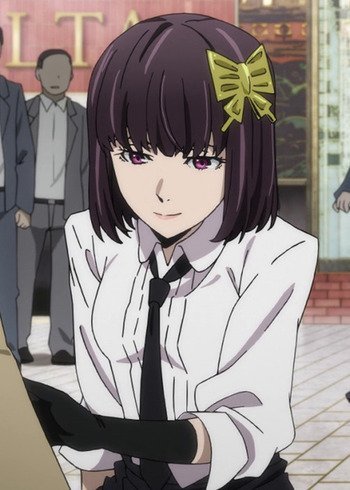
Around the age of twenty she started contributing her poems to magazines while she helped her family business. After participated in the Kansai Young Men's Literary Society, in 1900, she became acquainted with a waka poet Tekkan YOSANO at a poetry reading held at a Japanese-style hotel in Hamaderakoen and contributed her poem to "Myojo," an in-house magazine of Shinshisha (New Poetry Society) founded by Tekkan. In the following year she left her home and moved to Tokyo, and published her first poetry anthology "Midaregami" (Tangled hair) that expressed female sensuality in open fashion with which she established her style as a romantic poet. Later she married Tekkan.
In September 1904, she published a poem "Kimi Shinitamou koto nakare" (Thou Shalt Not Die) in "Myojo." In 1911, she contributed a poem that started with 'Yama no ugoku hi kitaru' (The day comes when a mountain moves) to the first issue of "Seito," the first female literary magazine in Japan. In 1912, Akiko followed Tekkan and moved to Paris, France. Ogai MORI helped her to raise money for going abroad with his wide range of literary works and large circle of contacts, and he also proofread "Shinyaku Genji Monogatari (New Translation of The Tale of Genji)" on behalf of Akiko to which he wrote the preface. On May 5, 1912, the Yomiuri Shimbun started a series of articles entitled 'Atarashii Onna' (New Women) with an article on Akiko's voyage to Paris, and on the following day the newspaper reported her departure (some 500 people including Raicho HIRATSUKA saw her off). The following June issue of the "Chuo koron" magazine ran a feature story on Akiko. On May 19, Akiko arrived in Paris via the Trans-Siberian Railway; during four months up to her leaving to Japan from Marseille, France on September 21, she visited England, Belgium, Germany, Austria, and the Netherlands and so on.
The same like Higuchi Ichiyou, Fukuzawa was praised for his work and put on the Japanese bill. Fukuzawa is respected and is still friends with Mori as evident in season 3 episode 9 where he said after leaving Lucy “I’m going to visit an old friend”.
Despite the many things Fukuzawa witnessed Mori do (which includes mentally abusing Yosano to have her ability of usage for the mafia) Fukuzawa still sees Mori as a friend and that is seen back with how Mori and Fukuzawa fought.
They both went for the more vital points of their body. Making their death quick and painless so that one cannot suffer compared to the other. Even when Pushkin was caught, the two had one brain cell in that moment and both punched the virus ability user.
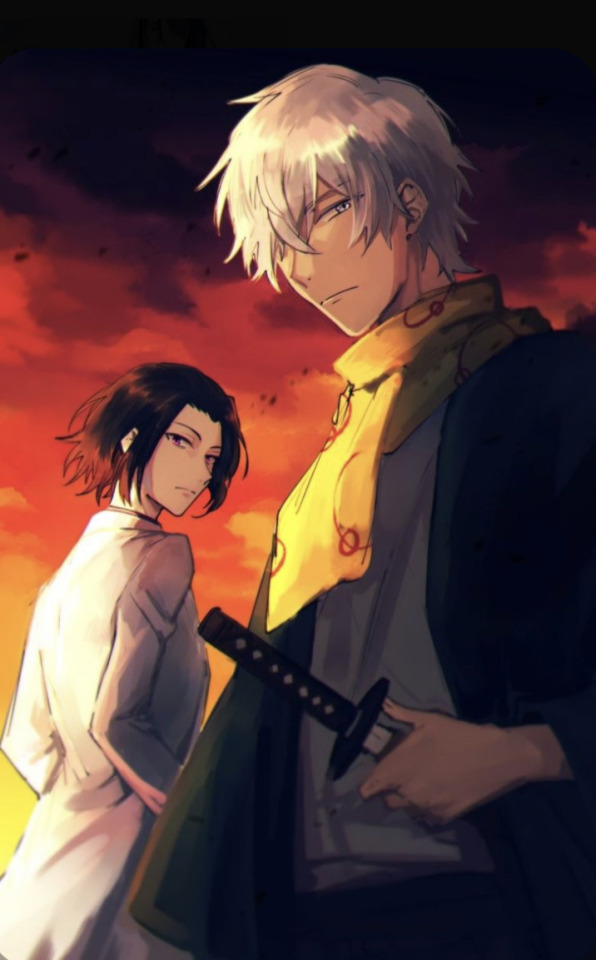
Why are Fukuzawa, Yosano and Natsume relevant you might ask? Well, let’s address the elephant in the room.
Let’s dissect season 1 episode 11 first (chapter 14 in the manga.)
We begin with how Mori Ougai is introduced, which is through Higuchi. After the failure that is capturing Atsushi and selling them for 4 billion yen/dollars Higuchi reports to Mori about their failure. This scene made me, a fan of the irl Mori Ougai’s work, open my eyes and ears to see how the two interact:
Higuchi: “I’m truly sorry for this.”
Mori: “Maybe he’ll never regain consciousness.”
Higuchi: “No way!”
Mori: “Don’t worry. You two have done you’re best. It’s true that you failed in the assault of the armed detective agency, erred during the capture of the man-tiger and sank the freighter along with our cargo. But you’ve done your best, and that’s all that mattered. Making effort is the most important. Results only come second, isn’t that right?”
Higuchi: “....”
Mori: “Oh, yeah. The trafficking company Akutagawa destroyed during the mission...the Remnants of Karma Transit seems to be recruiting. They’re probably planning to take revenge on Akutagawa.”
Higuchi: “what?”
Mori: “Listen, Higuchi-kun. The mafia is essentially an economic body that uses violence as its currency. It doesn’t matter at what got sunk or who got killed but if that violence is returned to us, all our expenses will become liabilities.”
Higuchi: “How could you call those liabilities? They were the fruits of of Akutagawa-senpai’s efforts up until now!”
Mori: “Indeed. Akutagawa-kun is highly capable. His violence is outstanding even in the mafia. **But what about you?** “
Higuchi: “....”
Mori: “Higuchi-kun. Have you ever wondered whether this job is really suited for you?”

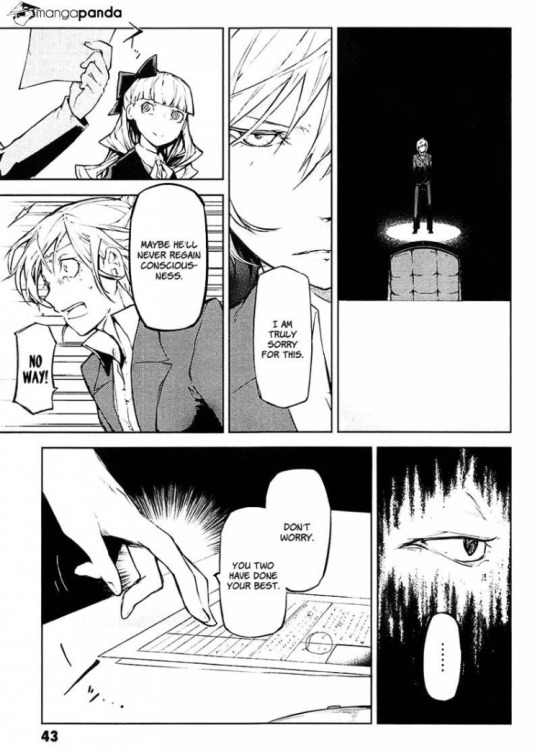
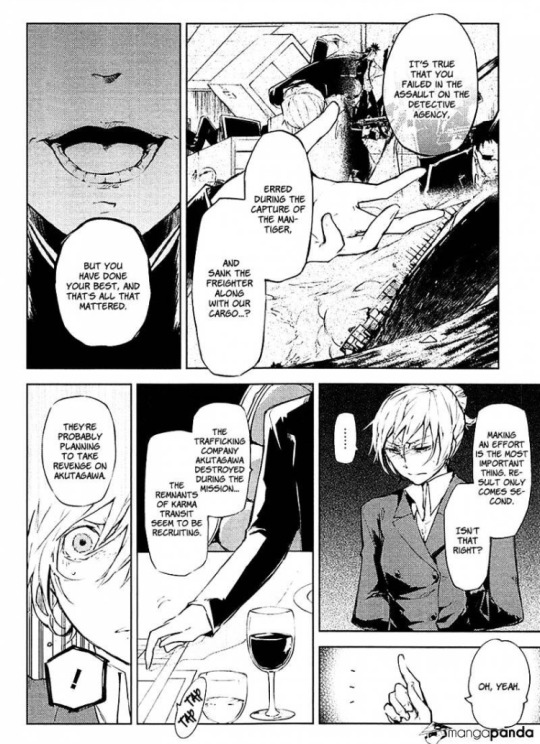

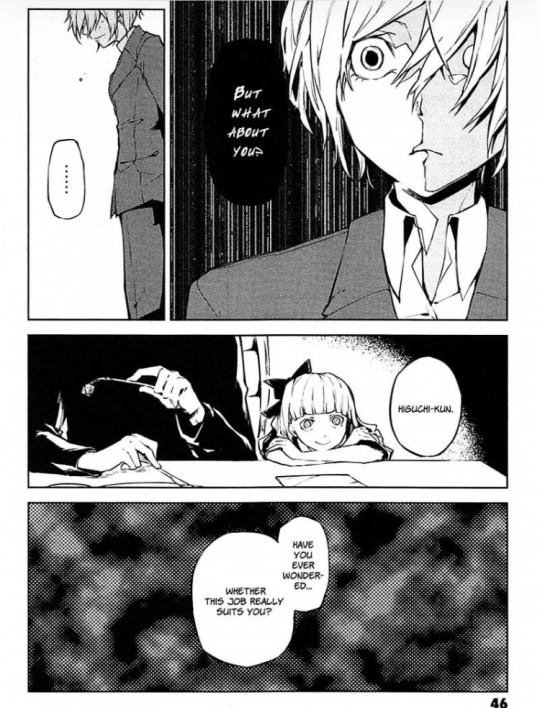
From what we have seen so far, Mori doesn’t seem angry at her actions. In fact, he seems more disappointed but with a hint of worry. Knowing real life mafia bosses, Higuchi would either get fired or tortured for her failures, yet she is here standing without any injuries. This is the most seen in the anime where Higuchi clearly is talking back to Mori, talking back to the king of the underworld.
The next scene is with the Black Lizards.
Tachihara: “This bastard Gin is always put onto sneaky jobs like infiltration and assassinations. Slitting the throats of families and friends on the higher ups order is quite a usual task. If he had meant it, you wouldn’t even have the time to gape.”
Higuchi: “Did the boss say he wanted me dead?”
Hirotsu: “Not yet, but who knows what will happen in the future.”
Higuchi: *cold face* “So you have come here to mock me?”
Hirotsu: “We’re only here to warn you to stay alert. If I were you I would come up with an insurance plan before the hitman starts closing in. The higher ups aren’t the only ones who are after your head. You and Akutagawa are the Guerrilla Squad directly under the boss’ command, giving you the authority to mobilize us in the combat squad, so your technically our superiors. However we don’t obey you out of your authority, but out of fear and respect for Akutagawa’s ability. Higuchi-kun, now that Akutagawa is out of action what power do you posses to make us obey you?”
Throughout the whole entire scene they say that Higuchi, despite her position as their superior, has not much authority over them. The only reason why they follow her is because she is under Mori’s direct order, so she and Akutagawa are second closes to Mori next to the executives.
Yet why is she here if she isn’t that important to the mafia according to the Black Lizards?
In the next page we see that she is against Mori’s order. Higuchi is going against Mori’s orders. This is a giant red flag because she is directly not following Mori’s order; this is enough to get executed under mafia rules yet she isn’t. How? How is she allowed to go through with this?
Let’s look further:
“But the only reason I never actually did it...”
“It’s not easy to break away from the mafia, but it’s not impossible.”
Let’s take the first sentence. She never finished it. She never said the reason why she never left. All we see is her remembering Akutagawa. This could mean one of two things; 1, she is in love with Akutagawa and wants to protect him or 2. She admires him for him using his ability more efficiently compared to her.
You might be asking, how did we go from Akutagawa to Higuchi’s ability? That’s simple.
Let’s remember Tachihara for example. At first we thought he wasn’t an ability user like Gin but it was later on revealed that his ability, Midwinter Memento, allows him to manipulate metal. While it has nothing in common, the name and the ability itself, this can be the same for Hirotsu.
Which means that authors have abilities, and Higuchi Ichiyou isn’t just some author. She is the first ever female author that got so high as being on a yen bill. So her not having an ability is rather suspicious.
Not only that but let’s look at how the novel 55 minutes describes her:
The novel described Akutagawa as an ability user, how would Higuchi not be described as a non-ability user? Because she is an ability user.
Which brings us back to the first take. Many mafioso’s would get in trouble for going against Mori’s word. With Higuchi it is differently; in season 1 episode 11 you see that Higuchi was talking to Mori on a rather even note, her eyes shined a few times which means that she appreciates the praises but she still went against his word by saying “Akutagawa has done so much to be considered a liability.” She talked back against the boss, that would be considered a punishment in the underground yet Mori kept her. This is also shown in the manga where in the mall, Higuchi talked once again back against him but Mori warned her as if she was a child that wants to know more about her birthday present.
Compare this to how he talks to Hirotsu; a mafioso who is longer in the mafia compared to Mori.
He talked back to him and he got a glare and was questioned “what do you want to say?” In a threatening type of way. Knowing Mori, it isn’t because of the former boss because Mori doesn’t care about him anymore nor is it about Dazai taking his place, that is his main goal.
My theory is that Higuchi’s ability is that big of a liability that she is Mori’s secret weapon.
In season 1 episode 11 she keeps saying “it is difficult to leave the mafia but the reason I stayed is because...”
She never finished her sentence. She never told the full reason why she stayed. In the manga we are shown that she isn’t respected, that subordinates walk over her. Yet even with these facts, Higuchi isn’t fired.
She also says “it is difficult to leave the mafia but it isn’t impossible”
That is a lie because as we have seen with Kyōuka it is impossible. How does Higuchi have such privilege? Because Mori knows she will come back. The reason why in her monologue it showed Akutagawa is because she admires him for being able to control Rashoumon, the same way how Atsushi finds Akutagawa amazing for being able to control Rashoumon.
Mori favors her, and this is shown in a panel in Wan where Higuchi does an impression of Mori when he is with Elise yet instead of being angry at Higuchi, Mori directs his glare to Chuuya and Tachihara. There is also a chapter where Tachihara, Higuchi, Akutagawa and Gin destroyed the Black Lizard hideout but instead of punishing Higuchi (who was the source of the accident) he punished them all.
Let’s look at another thing; how close is Higuchi with Mori?
Season 2 episode 8 where Mori was stabbed by Fyodor. It was brief but we see Higuchi together with the boss. Out of everyone in the mafia; Kouyou, Chuuya, Kajii hell even Akutagawa could (but he was busy looking for Nathanial) it was the least respected mafioso. Not only that but Higuchi back in season 2 gave information that the boss gave personally to Higuchi to send to Dazai.
This could have also been done by Hirotsu or Gin who know Dazai the longest. But something caught my attention. Higuchi said “I researched your history.” This wouldn’t seem bad was it not that Mori keeps Dazai’s executive position open for him to return, so Dazai is still technically an executive. ONLY EXECUTIVES are allowed to learn the history of the other executives. Gin, Hirotsu, Akutagawa, Kajii, Chuuya and Kouyou know about Dazai because they have an actual history with him but Higuchi is an outsider of this. She is like the other mafioso who aren’t related to Dazai yet she did research on him, which isn’t allowed.
Now this might sound as if Higuchi is special but let’s look at something or more someone who also didn’t look special but actually is special; Tachihara Michizo.
On the surface, Tachihara is an arrogant, impulsive, rash individual, more than willing to solve problems through sheer brute force and his dual guns. A violent temper leads to frequent conflict between him and other mafiosi, namely Gin, whom Tachihara views as creepy and frequently insults, leading to arguments, and Hirotsu, who often shuts Tachihara's temper down by threatening him. Tachihara's self-preservation prompts him to obey Hirotsu in the end, albeit reluctantly. An apparent thirst for battle and arrogance fuels Tachihara's temper. He's often seen with a rather feral smile on his face whenever fighting. He seldom considers the weight of a mission over the rush of eliminating his targets. He shows no hesitation nor remorse in murder, in fact sometimes urging to just eliminate a troublesome person if he finds their baggage more than they're worth.
A prideful man, Tachihara despises being underestimated and belittled. This is a surefire way to get oneself shot.
His rebellious side doesn't negate how he values orders, seeing them as an utmost system. Due to this, he attempts to dissuade Higuchi from saving Akutagawa against Mori's orders, even suggesting an alternate plan that wouldn't disobey these orders. Furthermore, he maintains his composure when dragged into shopping with Elise, and tolerates her putting bows in his hair. Despite guards laughing at him, Tachihara doesn't snap. Despite his rough exterior, Tachihara is capable of thinking rationally, just not in the heat of the moment in the Port Mafia. He can recognize danger quickly and finds himself on edge over how nonchalant Mori, Kōyō, and Chūya's meeting went. Tachihara has a proficient understanding of how to deal with the enemy, alluding to a much more cunning side of his true nature.
Much of Tachihara's details of joining the Port Mafia are unknown, however, it is a ruse. His identity as the fifth Hunting Dog reveals a much more clever, driven man. Unlike Ango Sakaguchi, Tachihara always intended to infiltrate the Port Mafia, using his position in the Hunting Dogs to operate as a spy. His confrontation with Yosano is devoid of any rage, depicting a cold, blunt side as he explains his grudge against her for "killing" his brother. Regardless of who he is working for, Tachihara cares deeply for his comrades. He was first to try to stop Higuchi when she tried to save Akutagawa on her own and has been seen visibly harboring guilt for when he cut down Hirotsu and Gin for the sake of his mission as a spy. He has also been seen caring for Teruko when she showed she was heavily injured from going against a plane head-on. He's also notably patient with those who are spoiled, including letting Teruko sit on her shoulders with little protests of being her "slave" and letting Elise put a bow on his head.
Beneath a lot of Tachihara's rough and punk-like exterior is a strong sense of incompetency and inferiority compared to his elder brother who was praised as being "perfect" while he was deemed by his family as being inferior, even being questioned as to why he didn't die instead of him. These things have driven Tachihara to act out and live a life of delinquency and ruthlessness by affiliating with gang activity, but despite these things, he still couldn't shake off these negative feelings. His insecurity and desperation to escape his brother's shadow was so strong, that Tachihara took on the first "order" that allowed him to become someone "not like his brother or his opposite" and joined the Hunting Dogs and infiltrate the Mafia to get revenge on Yosano for "killing" his brother, even when he knew and acknowledged that all of it was an excuse to appease his own negative feelings.
Many didn’t think much of Tachihara next that he was a commander of the Black Lizards and just someone who is close with Chuuya in Wan, however in the current arc we learn that he is a member of the Hunting Dogs with his ability Midwinter Memento being perfect for to lure Yosano to him, and in his fight with Fukuchi we learn that Mori giving him the order to kill Fukuchi was perfect for him.
Tachihara’s ability is named after his famous poem;
*Neither pursuing nor being pursued,
I stand under a barren tree. I'm watching
my silhouette, now marooned on a spotless snow....
(My pale shadow somberly takes shape.)
I'm listening. Yes! I certainly
am listening to what my shadow sings....
In a plaintively nasal voice it sings tunes of long-gone
summer flowers never to return.
Without responding, "That's a bunting, that's a siskin,
that's a white fir
—that's me...I a siskin, I a fir...," my shadow and I
eye each other as though these statements once were true.
My shadow listens to my heart at song.
Like the hubbub of that old arrowing brook,
it listens to tears at song...on the snow.*
This poem is seen mostly how Tachihara lives in the shadow of his brother, how much he listens to what others have to say because he himself can’t find a reason to do something.
As we already had established, Higuchi Ichiyou is a famous female writer. And the characters based on the authors and their books have an ability.
However there are two (three) categories: Name based abilities and non-name based abilities.
(Three being a non-abilities)
Non-abilities: The Great Old Ones and Ultra-Deduction.
Name based: Beast Beneath The Moonlight, Doppo Poet, All Men Are Equal, Lemon Bomb, The Great Fitzgerald, Thou Shalt Not Die, Gone With The Wind, I Am A Cat, A Feast in Time of Plague, Anne of Abyssal Red, Moby Dick, Time Machine, Yesterday’s Shadow Tag, The Grapes of Wrath etc.
Non-name based abilities: Vita Sexualis, Midwinter Memento, Another, An Inherent Drop, Black Cat in the Rue Morgue, Little Woman, Demon Snow/Golden Demon, Flawless, Futon, Plum Blossom in Snow, Priceless Tears, Undefeated By the Rain, No Longer Human, For The Tainted Sorrow etc.
Higuchi Ichiyou’s famous short story Takekurabe (Growing Pains) could be her ability based on that Mori Ougai had praised her for it, which eventually became they key to her success;
“ * [Higuchi Ichiyō’s] ‘Growing Pains’ was acclaimed as a masterpiece, especially when the entire work was republished in a single issue of the popular magazine Bungei Kurabu in April 1896, Mori Ōgai… lavishly praised its every feature: … (Ōgai): It is not especially remarkable that this author, a member of a literary circle in which the Naturalist school is said to be enjoying a vogue should have chosen to set her story in this place [the Yoshiwara district]. What is remarkable is that the characters who haunt this area are not the brute beasts in human form - the copies of Zola, Ibsen, and the rest - presented by the assiduous imitators of the so-called Naturalist school, but human beings with whom we can laugh and cry together… . At the risk of being mocked as an Ichiyō-idolater, I do not hesitate to accord to her the name of ‘poet.’ It is more difficult to depict a person with individual characteristics than a stereotype, and far more difficult to depict and individual in a milieu than a special person all by himself. This author, who has painted the ‘local coloring’ of Daionji-mae so effectively that one might say it has ceased to exist apart from ‘Growing Pains,’ without leaving any trace of the efforts such portraiture must have cost her, must truly be called a woman of rare ability.* “
(Credit to Donald Keene, Dawn to the West.)
But what could Growing Pains do if it was actually an ability? For most we need to understand what an actual ability needs to have in common.
For this we will take For The Tainted Sorrow and see how this ability is related to gravity?
With literal names based abilities we look at Atsushu. Atsushi has the ability to transform into a white tiger. At first, he doesn't seem to have much control over the transformation, likely due to the fact, or caused by, his unawareness of his state as an Ability user. After becoming an official member of the Agency and under the influence of All Men Are Equal, he gains more control over his transformations - as shown during his second fight with Akutagawa, when he breaks the transformation on his arms to escape.
My theory is that Higuchi’s ability allows her to paralyze her enemies.
Let’s look as too why I think this and use the summary of Takekurabe as an example; The main characters are children living on the edge of Yoshiwara, the only district of Edo that was licensed for prostitution. As they grow up, they find themselves assuming their family professions and losing the freedom they enjoyed as children. Next we have Nigorie translated into English as Troubled Waters and Muddy Water, is a Japanese short story written by Higuchi Ichiyō in 1895. It depicts the fate of a courtesan in the red light district of a nameless town during the Meiji era. Nigorie centers around Oriki, the most popular courtesan at the Kikunoi, a brothel in the red light district of an unspecified town, and a group of people connected to her, during the summer Obon festival. Through her conversations with other prostitutes, and Oriki's accounts in the presence of new customer Yūki Tomonosuke, the reader learns that a previous customer, Genshichi, a futon salesman of moderate affluence, was addicted to Oriki and spent all his money at the brothel. Now that Genshichi has been reduced to the hard labor of a construction worker, forced to move with his wife Ohatsu and his young son Takichi into a smaller flat in a run-down section of town, Oriki rejects seeing him despite his pleas. Tomonosuke repeatedly questions Oriki during his visits. She reminisces about her poor upbringing, which she cites, together with her profession, as the reason for not wanting to marry, although she had contemplated the possibility. She recounts a childhood incident when she was seven years old, sent by her mother to buy rice for supper. On her way back, she slipped on the frozen ground, spilling the rice into the gutter, leaving the family starving for this day. Meanwhile, Ohatsu scolds Genshichi for his ongoing obsession with Oriki and the family's poverty, which she tries to mitigate by doing piecework. When Takichi comes home with a piece of cake, which he received as a gift from Oriki (whom he refers to as "the demon-lady"), Ohatsu angrily throws it away. Genshichi, furious about her ongoing accusations and behaviour, demands that she leaves him. Ohatsu begs him to let her stay, as she has no relatives she can return to, but finally leaves, taking their son with her. At the end of the festivities, the dead bodies of Oriki and Genshichi are found. While it seems obvious that Genshichi committed suicide by seppuku, the cause of Oriki's death stays unclear. The passerbys speculate about her fate; while one assumes a shinjū (double love suicide), another one reasons that the wounds on Oriki's body make a murder after her attempted escape more plausible. It is left to the reader to determine the true circumstance of her death.
From these famous stories we can already determine that Higuchi’s stories are centered around the concept of one-sided attraction. This is something she and Akutagawa have, a one-sided attraction. This is the most in season 3 episode 5 where Higuchi doesn’t seem to find her way of trying to confess that she loves Akutagawa or that she thinks she admires him. And what is there not to admire about Akutagawa? He has an amazing ability, he is reliable in many ways but is just stubborn. So with this in mind, Higuchi’s (if this theory is correct) ability comes in this form; Higuchi’s ability is a mix of a non-name based ability and a name-based ability. The ability of paralyzation has the meaning of that she is paralyzed by fear with job as a mafioso but also her fear of being rejected by Akutagawa and that it is the greatest liability Mori has in order to protect Yokohama-This idea comes more in mind in the manga, Chapter 41, where we briefly see Higuchi’s little sister. This may not mean much to you but Higuchi is the only confirmed character with a little sister who isn’t based on a book (Gin=Ogin and Naomi=Naomi). Which leads me to the reason why she doesn’t use her ability anymore or is restricting herself- and the second is the meaning of Growing Pains ; Growing pains are often described as an ache or throb in the legs — often in the front of the thighs, the calves or behind the knees. Growing pains tend to affect both legs and occur at night, and may even wake a child from sleep. Although these pains are called growing pains, there's no evidence that growth hurts.
There could have been an incident in which Higuchi accidentally used her ability on her little sister which resulted in her little sister being paralyzed. She could have met Mori and knowing Mori he manipulated in keeping her ability a secret and for repayment let her join the mafia. This idea is further proven with how he was with Yosano; after the death of Tachihara’s brother Mori manipulated Yosano into thinking that this is her fault, almost making her join the mafia out of guilt was it not for Ranpo.
6. Maybe Higuchi wasn’t as lucky and thought that what Morti said was true and joined the mafia out of guilt, which leads me as to why she fell in love with him. The nightingale effect; The Florence Nightingale effect is a trope where a caregiver falls in love with their patient, even if very little communication or contact takes place outside of basic care. Feelings may fade once the patient is no longer in need of care. Higuchi fell in love with Akutagawa not out of admiration but out of care for him. That guilt of not being able to take care of him could be because of her little sister and the fear that Higuchi one day paralyzes Akutagawa, as to why she isn’t using her ability. After all, this isn’t the first time there was a character who hid their ability to do things without it; Fyodor and Tachihara.
And the last thing that might confirm Higuchi’s importance is the way she acted in Wan and the Onsen drama CD. While Wan is merely a comedy it does call out the characters for their flaws and unique personalities, meanwhile the Onsen drama CD is like a filler but adds information about certain characters and their relationship; Higuchi included.
1. She stalks Akutagawa at first out of fear that other organizations might attack him, but at this point she stalks him with a mix of worry and not being capable of walking up to him.
2. She is rather open to nudity as shown that she said to Chuuya “it is my job to help Akutagawa even it means being naked” (or something along those lines).
In a certain chapter however where the Port Mafia had to disguise themselves as Mori, Higuchi was up and while she failed to look like Mori because she is very feminine she then used another tactic which is acting like Mori when he is with Elise. For most, Mori would have either glared at them and give them punishment, he glared at Chuuya and Tachihara (who were the closest next to him) instead at Higuchi. Higuchi broke many Port Mafia rules, many times she failed and has unintentionally mocked him yet she is still here.
so what do you guys think? Is this theory plausible?
#higuchi ichiyo#higuchi bsd#theories#speculation#bungou stray dogs#mori ougai#yosano akiko#tachihara michizou#ability
89 notes
·
View notes
Link
Authentic Japanese Vintage Kimonos by pound:10 Pounds & up, US$6 - 11.50 per lb; vintage Japanese kimono fabrics and more, SHIP FROM USA. founded 1989, online since 1998 https://www.yokodana.com/products/6448-1950s-japanese-kimono-silk-fabric-piece-araihari https://www.yokodana.com
#kimono#vintagestyle#instaquilt#着物#浴衣#和装#kemejalucu#jualkemejakerja#jualkemejawanita#vintagekimono#kemejakuliah#kimonomurah#yukata#kemejacewekmurmer#jualkemejakuliah#jualkemejapolos#vintageshop#kemejacewe#instasew#bulkkimono#きもの#jualkemejakantor#kemejacewekmurah#jualkemejacewek#girlskimono
1 note
·
View note
Photo

It’s laundry day! We found these instructions for washing silk kimonos, but they came with disclaimer saying that you do so at your own risk![1]
Fill a bucket with cool water.
If required, stir in a small drop of mild, non-alkaline detergent or baby shampoo.
If the water in your area is hard, add a little Borax substitute to soften it.
Place your kimono in the bucket and gently swirl for a minute or two, taking care not to scrub at it or leave it in for too long.
Rinse the kimono carefully to remove any suds.
Air dry outdoors on a hanger away from direct sunlight.
Do not wring it out, tumble dry it or iron it, as such treatment will damage the fabric.
Make sure it's completely dry before folding and storing.
Woman washing kimono, Japan Hand-colored lantern slide 1900-1940
Kimono is pulled apart, the pieces are handwashed and then stretched over a plank, a process known as "araihari." Once the pieces are dry they are made into kimono again.
8 x 10 cm Etz, Roger Frederick (1886-1950, American), collector Trudell, Dorothy Etz, donor Showa Period (1926-1989); Taisho; Meiji
Harvard Fine Arts Library Special Collections
[1] http://www.thejapaneseshop.co.uk/kimono-care-instructions.html
#lanternslide#japanese photography#early photography#special collections#kimono#fineartslibrary#harvardfineartslibrary#harvard library#Harvard
21 notes
·
View notes
Link
Authentic Japanese Vintage Kimonos by pound:10 Pounds & up, US$6 - 11.50 per lb; vintage Japanese kimono fabrics and more, SHIP FROM USA. founded 1989, online since 1998 https://tinyurl.com/yyn459yt https://www.yokodana.com
#kimono#vintagefashion#jualkemejapolos#kemejalucu#bulkkimono#kemejacewekmurmer#kemejacewekmurah#jualkemejawanita#着物#instaquilt#振袖#jualkemejakerja#kimonomurah#instasew#vintagekimono#jualkemejakantor#jualkemejacewek#jualkemejakuliah#vintagestyle#浴衣#kemejacewe#yukata#girlskimono#kemejakuliah#きもの
1 note
·
View note
Photo
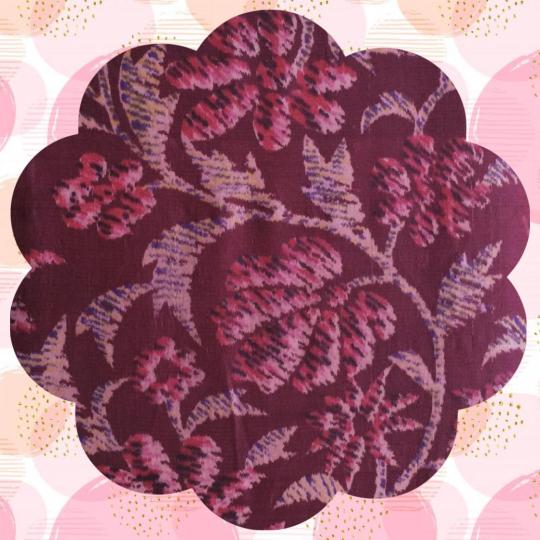
6416: 1950s Japanese Meisen Silk Fabric, By Piece 53in. (AraiHari) for just $15.00 Vintage Japanese Textiles: 1950's Meisen Silk Fabric Piece Width: 13.75 inches / 34.92 cm Length: 53 inches / 134.62 cm Catalog# 6416: US$15.00 per piece USA Shipping free under 4 pounds Fabric History/Pedigree: Pieces received from traditional Japanese kimono cleaner/reconstructor called Arai-Hari -- see an excellent explanation of traditional Arai Hari by textile expert John Marshall,by click-pushing HERE. Fabric Description: Lightweight meisen silk is a 1950's piece; Meisen is defined literally as 'common silk stuff'; and has grown in popularity in the last few years; Meisen from that period are usually larger bold patterns and bright colors. See close-ups. Fabric Motif: Distinctive Japanese traditional design of large scale floral and stems/leaves motif filling the fabric; Background color is burgundy with designs in reds, black, mustard and a pinkish-tan; As is typical in Meisen, note the impressionistic fuzzy edges; patterns same on both sides; Colors: Reminder that colors differ on different devices, so please refer to our text color descriptions. Condition: Excellent. Cultural Notes: The best discussion we've found of Meisen silk fabric was on an old blog post by Japundit, excerpted here, from the early 2000's*: "...Young women have rediscovered(Japan Times) the kimono, and you can see them out in Harajuku on the Sunday fashion parade. There's even a term for these girls -- not surprisingly they are called "kimono girls." There are even some nice books documenting the trend which you can check out at J-List and are definitely worth having if you are at all into fashion...."The meisen kimono, in particular, has become very popular. These kimono were made in the first half of the twentieth century, and were characterized by a glossy sheen, and brilliant patterns. There is often a sort of blurry quality to the silks...." [*original article is no longer on the internet.] more info on meisen is here.
0 notes
Photo
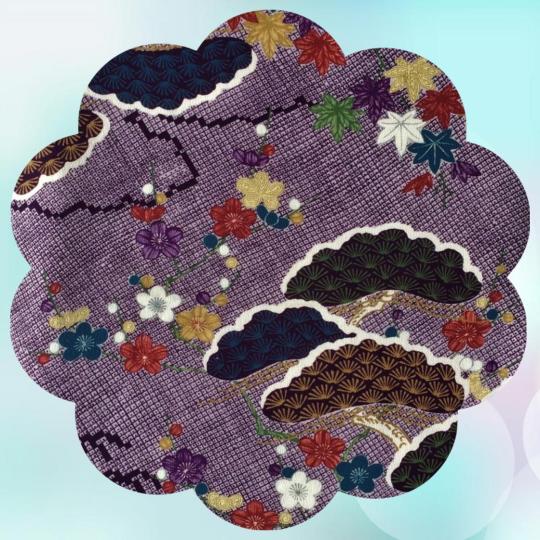
6424: 1950s Japanese Kimono Silk Fabric Piece 57" (AraiHari) for just $20.00 Vintage Japanese Textiles: 1950's Silk Fabric Piece Shibori Arai-Hari Width: 14 inches / 35.56 cm Length: 57 inches / 144.78 cm Catalog# 6424: US$20.00 per piece USA Shipping free under 4 pounds package weight Fabric History/Pedigree: Pieces received from traditional Japanese kimono cleaner/reconstructor called Arai-Hari -- see an excellent explanation of traditional Arai Hari by textile expert John Marshall,by click-pushing HERE. Fabric Description: Lightweight silk originally intended to make a woman's kimono; This is a 1950's fabric piece with a purple background which is filled with smaller shibori-dots print design (not tie-dyed shibori) in off-shite; Classic motifs include: royal carriage, partial view of the veranda of a country home, maple leaves, peonies, pine branches, multi-colored cherry blossoms and plum blossoms; a Wider range of brightly colored to dark colors used in the design patterns, including the following: mixed blues, greens, iron-red, tan, off-white, mustard, dark lavender; this is a print fabric so designs on one side, but visible on reverse; no-sheen, some drape. Recommended for making scarf or accessories. Condition: Excellent.
0 notes
Photo
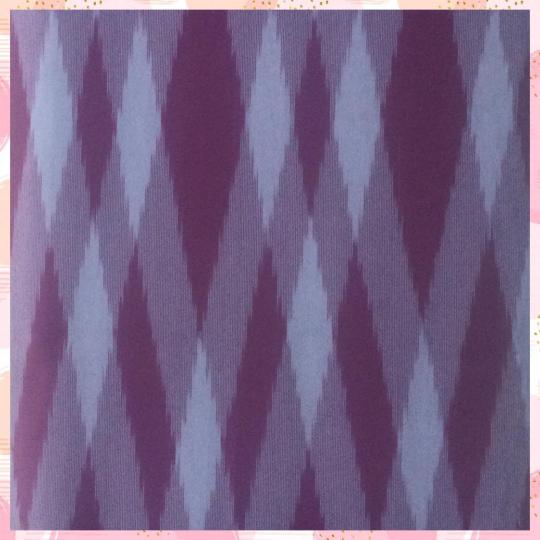
6436: 1950s Japanese Kimono Silk Fabric Piece 58" (AraiHari) for just $15.00 Vintage Japanese Textiles: 1950's Silk Fabric Piece Arai-Hari Width: 14 inches / 35.56cm Length: 58 inches / 147.32 cm Catalog# 6436: US$15.00 per piece USA Shipping included under 4 pounds package weight Fabric History/Pedigree: Pieces received from traditional Japanese kimono cleaner/reconstructor called Arai-Hari -- see an excellent explanation of traditional Arai Hari by textile expert John Marshall,by click-pushing HERE. Fabric Description: Lightweight silk originally intended to make a woman's kimono; This is a 1950's fabric piece done in an unusually small and dense weave giving it a rougher texture, slightly stiff compared to most silks; background color is burgundy with designs in tiny grayish-blue pinstripes configured to create a pattern of elongated diamond-shaped thatch work grid; Some of the diamond shapes are solid; This design is evocative of how kasuri has blurred and fuzzy edging of figures; design same on both sides; no-sheen, minimal drape. Recommended for making scarf or accessories. Condition: Excellent.
0 notes
Photo
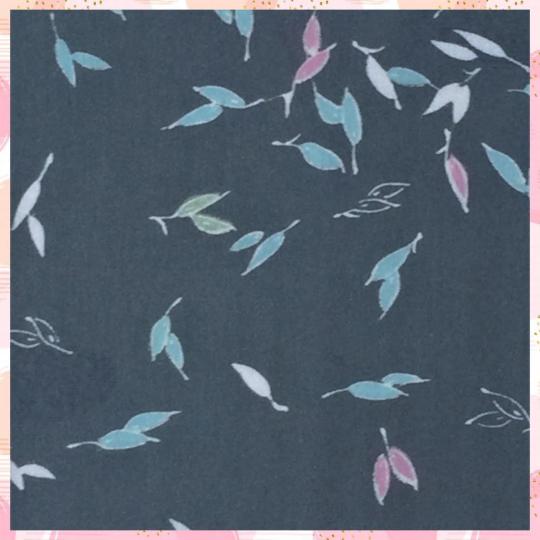
6456: 1930s-50s Japanese Kimono Silk Fabric Piece 53" (AraiHari) for just $15.00 Vintage Japanese Textiles: 1930s-1950s Silk Fabric Piece Falling Leaves Arai-Hari Width: 13.75 inches / 34.92 cm Length: 53 inches / 134.62 cm Catalog# 6456: US$15.00 per piece USA Shipping included under 4 pounds package weight Fabric History/Pedigree: Pieces received from traditional Japanese kimono cleaner/reconstructor called Arai-Hari -- see an excellent explanation of traditional Arai Hari by textile expert John Marshall,by click-pushing HERE. Fabric Description: Fine lightweight silk, slightly translucent in bright light, originally intended to make a woman's kimono; This is a good quality silk fabric piece with solid dark-blue-green background; motifs are of falling leaves, all in pastel shades of pink, blue and off-white; soft to touch, slight drape; Designs on one side only, faint on reverse. Note on colors: As all devices have differing coloration, please use our text descriptions of colors to complement your sense of the color of the fabric. Recommended for making scarf or accessories. Condition: Excellent.
0 notes
Photo

6435: 1950s Japanese Kimono Silk Fabric Piece 59" (AraiHari) for just $15.00 Vintage Japanese Textiles: 1950's Silk Fabric Piece Arai-Hari Width: 14 inches / 35.56 cm Length: 59 inches / 149.86 cm Catalog# 6435: US$15.00 per piece USA Shipping included under 4 pounds package weight Fabric History/Pedigree: Pieces received from traditional Japanese kimono cleaner/reconstructor called Arai-Hari -- see an excellent explanation of traditional Arai Hari by textile expert John Marshall,by click-pushing HERE. Fabric Description: Lightweight silk originally intended to make a woman's kimono; This is a higher quality 1950's silk fabric piece with a background of dark burgundy with a hint of brown; background is interwoven with distinctive designs of pine needles and various flowers as well as some squares with floral figures -- all these are in more sheen than rest of fabric); color motifs are chrysanthemums and daffodils, as well as tiny spots of single pink cherry blossoms throughout; colors used are dark pastels of orange, pink, yellow, blue, green, and lavender, plus a few lime-green; this is print fabric so designs on one side, but visible on reverse; sheen as described, slight drape. Recommended for making scarf or accessories. Condition: Excellent.
0 notes
Photo
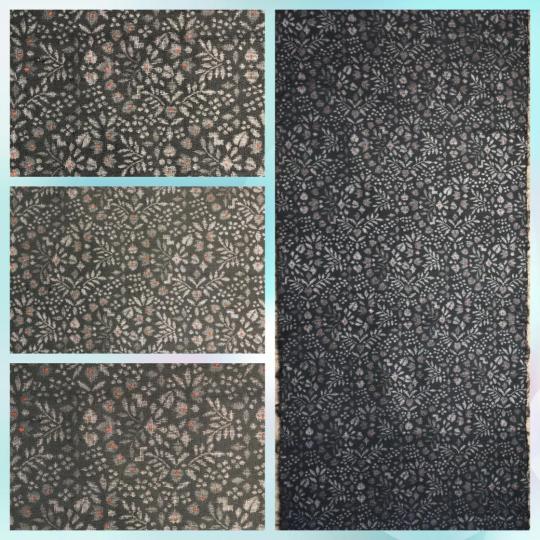
6082:1970s Japanese Kimono Silk Fabric, Metallics, 54" (AraiHari) for just $15.00 Vintage Japanese Textiles: 1980's Kimono Silk Fabric Piece Width: 14.5 inches / 36.83 cm Length: 54 inches / 137.16 cm Catalog# 6082: US$15.00 per piece USA Shipping free under 4 pounds package weight Fabric History/Pedigree: Pieces received from traditional Japanese kimono cleaner/reconstructor called Arai-Hari -- see an excellent explanation of traditional Arai Hari by textile expert John Marshall,by click-pushing HERE. Fabric Description: Light-medium weight silk This is a 1970's piece in a black background with hint of dark emerald green (depends on lighting to see the greens0; motifs are of flowers and leaves which are rendered with metallic silver-white designs on one side, tiny iron-red accents in some flowers; Reverse side is solid; see close-ups. Colors: Please remember that colors shown may differ on different devices. Please note the colors listed in the text here. Condition: Excellent.
0 notes
Photo

5822: 1960's Japanese Silk Fabric, 57 inches (AraiHari) for just $15.00 Vintage Japanese Textiles: 1960's Silk Fabric Piece Arai-Hari Width: 14.25 inches / 36.2 cm Length: 57 inches / 144.78 cm Catalog# 5822: US$15.00 per piece USA Shipping included under 4 pounds package weight Fabric History/Pedigree: Pieces received from traditional Japanese kimono cleaner/reconstructor called Arai-Hari -- see an excellent explanation of traditional Arai Hari by textile expert John Marshall,by click-pushing HERE. Fabric Description: Lightweight 1960's Japanese kimono silk which is burgundy & black background with designs in soft-white shapes in black outlined figures with various geometric patterns; atypical design combines floral with geometric look in interesting way; has a kasuri-type look (fuzzy boundaries) to it but is not strictly speaking a kasuri; same on both sides. Condition: Excellent.
0 notes
Photo
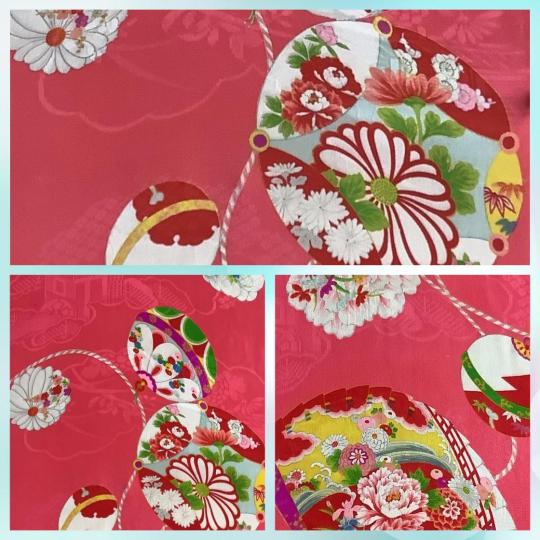
6820: 1930s-50s Japanese Kimono Silk Fabric 52" Piece,Ornate,Floral Fans, AraiHari for just $20.00 Vintage Japanese Textiles: 1930's-50s Silk Fabric Piece (Ornate, Floral, Fans, Temari Balls) Arai-Hari Width: 13.75 inches / 34.92 cm Length: 52 inches / 132.08 cm Catalog# 6820: US$20.00 per piece USA Shipping included under 4 pounds package weight Fabric History/Pedigree: Pieces received from traditional Japanese kimono cleaner/reconstructor called Arai-Hari -- see an excellent explanation of traditional Arai Hari by textile expert John Marshall,by click-pushing HERE. Fabric Description: Lightweight fine red silk originally intended to make a woman's dress kimono; This is a 1930s-1950s fabric piece which is a dark salmon background color that is interwoven with many classical designs, including country house porch, shibori-dot fields/pond, pine branches, clouds, and other flowers; foreground designs are of elaborately decorated fans and also Temari(decorative balls),also flower clusters and decorative cords; Within the fans are many types of flowers, family-crests, Japanese bridge, maple leaves, and more flowers; Colors within the designs and figures are very red, (dark to light), yellow,green, bue, plum, peach colors; light pinks, dark aqua-blues, dark reds, yellow and mustard, whites, and some greens; (see closeups); This is a print process, so designs are on one side, but as the fabric is thin, some of the designs can be seen on the reverse. Note on colors: As all devices have different colorations and contrast, please use our text descriptions of colors to complement your sense of the color of the fabric. Condition: Excellent
0 notes
Photo
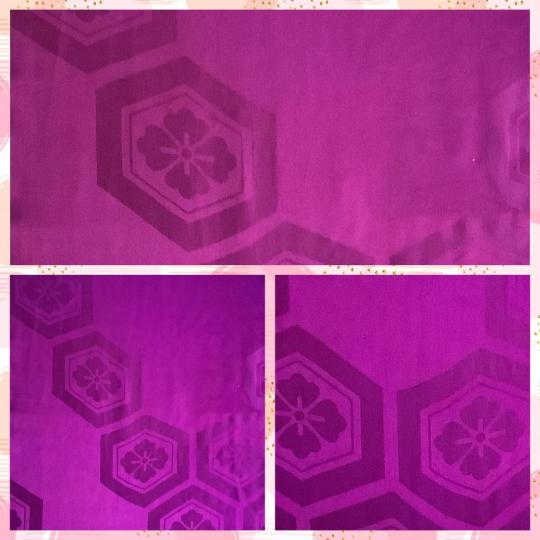
6819: 1960s Japanese Kimono Silk Nagajuban Fabric, 56in. Piece(AraiHari) for just $18.00 Vintage Japanese Textiles: 1960s Silk Nagajuban Fabric Piece (Arai-Hari) Width: 14.75 inches / 37.47 cm Length: 56 inches / 142.24 cm Catalog# 6819: US$18.00 per piece USA Shipping included under 4 pounds package weight Fabric History/Pedigree: Pieces received from traditional Japanese kimono cleaner/reconstructor called Arai-Hari -- see an excellent explanation of traditional Arai Hari by textile expert John Marshall,by click-pushing HERE. Fabric Description: Lightweight 1960s silk; originally intended to make a woman's nagajuban or kimono liner; Background color is a dark Fuschia color with large hexagonal family crests(mon) shapes in symmetric grid interwoven throughout; Designs are the same on both sides; some sheen in most of the large mon(crest) shapes, less in others (see close-ups). Note on colors: As all devices have different colorations and contrast, please use our text descriptions of colors to complement your sense of the color of the fabric. Condition: Excellent. Recommended for making scarf or accessories
0 notes
Photo
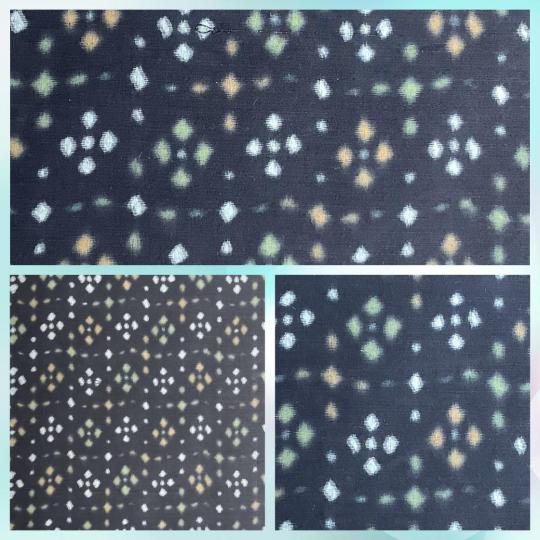
6810: 1930s-50s Japanese Meisen Silk 65 in. Piece(AraiHari) for just $20.00 Catalog# 6810 1930s to 1950s Japanese Textiles: From Arai-Hari Cleaners Japanese Kimono Meisen Silk Fabric Piece Width:14 inches / 35.56cm Length: 65 inches / 165.1 cm US$20.00 per piece Item Details and Description Fabric History/Pedigree: 1930s to 1950s silk fabric pieces received from traditional Japanese kimono cleaner/reconstructor called Arai-Hari -- see an excellent explanation of traditional Arai Hari by textile expert John Marshall, by click-pushing HERE. Fabric Description: Meisen silk, lightweight and slightly translucent, slightly stiff and rough texture; a distinctive motif of rectangular shapes in checkerboard layout type grid, each rectangular shape being 3 inches / 7.62 cm tall; These shapes and lines used to render them are made of small fuzzy diamond shapes (not in continuous lines); Each rectangular area is filled with a diamond configuration of 4 with one smaller diamond in center; fabric background is black; design colors are all muted and fuzzy light mustard, light peach-tan colors, and off-white; note the intentional fuzzy edges are typical of this period's Meisen silks. This piece same on both sides; no sheen. Colors: Please NOTE that colors and contrast differ on each device so use our text descriptions to complement your sense of the fabric). Condition: Excellent Background Information on Meisen Kimonos: Meisen is defined literally in our Kenkyuusha dictionary as "...common silk stuff"; meisen fabrics (or garments made from them) are currently called 'meisen'; Meisen kimono were made similarly to kasuri (ikat) , though meisen usually have very colorful patterns with distinct -- often more modern -- motifs and a slight sheen; 1950s meisen have intentionally fuzzy, almost Impressionistic look and often larger designs; Kasuri/ikat, of course, is mostly indigo blue and some white with black. To learn more about kasuri click here. To see pictures of meisen silk vintage kimonos from Google, touch HERE. Other Cultural Notes: The best discussion we've found of Meisen silk fabric was on an old blog post by Japundit, excerpted here*: "...Young women have rediscovered(Japan Times) the kimono, and you can see them out in Harajuku on the Sunday fashion parade. There's even a term for these girls -- not surprisingly they are called "kimono girls." There are even some nice books documenting the trend which you can check out at J-List and are definitely worth having if you are at all into fashion. "The meisen kimono in particular has become very popular. These kimono were made in the first half of the twentieth century, and were characterized by a glossy sheen, and brilliant patterns. There is often a sort of blurry quality to the silks...." [*original article has been pulled] Top
0 notes
Photo

6775: 1930s-50s Japanese Meisen Silk 59 in. Piece (AraiHari) for just $20.00 Catalog# 6775 1930s to 1950s Japanese Textiles: From Arai-Hari Cleaners Japanese Kimono Meisen Silk Fabric Piece Width:14 inches / 35.56 cm Length: 59 inches / 149.86 cm US$20.00 per piece Item Details and Description Fabric History/Pedigree: 1930s to 1950s silk fabric pieces received from traditional Japanese kimono cleaner/reconstructor called Arai-Hari -- see an excellent explanation of traditional Arai Hari by textile expert John Marshall, by click-pushing HERE. Fabric Description: Lightweight Meisen silk, slightly translucent, somewhat stiff, no sheen; the background is cream color with a diamond-shaped reticular grid; intentionally fuzzy edges are in black and gray with small square red accents in rows at junctures an din center of diamond shapes; somewhat unusual meisen design; This piece same on both sides. Colors: Please NOTE that colors and contrast differ on each device so please use our text descriptions to complement your sense of the fabric. Condition: Excellent Background Information on Meisen Kimonos: Meisen is defined literally in our Kenkyuusha dictionary as "...common silk stuff"; meisen fabrics (or garments made from them) are currently called 'meisen'; Meisen kimono were made similarly to kasuri (ikat) , though meisen usually have very colorful patterns with distinct -- often more modern -- motifs and a slight sheen; 1950s meisen have intentionally fuzzy, almost Impressionistic look and often larger designs; Kasuri/ikat, of course, is mostly indigo blue and some white with black. To learn more about kasuri click here. To see pictures of meisen silk vintage kimonos from Google, touch HERE. Other Cultural Notes: The best discussion we've found of Meisen silk fabric was on an old blog post by Japundit, excerpted here*: "...Young women have rediscovered(Japan Times) the kimono, and you can see them out in Harajuku on the Sunday fashion parade. There's even a term for these girls -- not surprisingly they are called "kimono girls." There are even some nice books documenting the trend which you can check out at J-List and are definitely worth having if you are at all into fashion. "The meisen kimono in particular has become very popular. These kimono were made in the first half of the twentieth century, and were characterized by a glossy sheen, and brilliant patterns. There is often a sort of blurry quality to the silks...." [*original article has been pulled] Top
0 notes